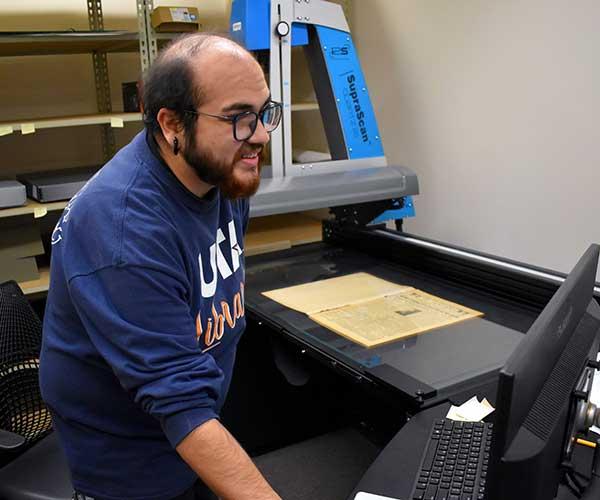
by Library News

In the basement of the UTA Central Library, the Digitization Services Unit staff members are working to preserve pieces of the past. Each document, photograph, book, video, and audio recording is transformed into a new digital format for future generations.
Mark Cook, Digitization Services Manager, stated that this preservation work helps connect people with their own history.
"We recently had a patron contact us and said his mother had graduated in the early 1970s and had written a dissertation. He didn't know-how to get a copy of it," Mark said. "David Hayden, our Stacks Manager, was able to pull the copy for me and I digitized it and sent it to the family member."
Mark shared that they get requests like this throughout the year when people see a particular document or item online with a family connection through a website like the Digital Gallery and contact us for help.
Digitization Services is working on several projects that help to tell stories connected to the university and the local community. The Digital Services staff is working to scan UTA commencement programs from the 1920s to the present, copies of the student newspaper "The Shorthorn" dating starting in 1919 and university yearbooks. They are also digitizing the personal papers of several well-known North Texas families dating from the 1800s.
The unit's work connects people from around the globe to the university. An online search expands the reach of Libraries, bringing people to campus virtually. In one such instance, a family reached out after they saw an image of a family member on the Libraries' Digital Gallery website.
"This happened quite a few years ago when we digitized the 1940s negatives from the Fort Worth Star-Telegram. During that time when servicemen would get killed during the war, the Fort Worth Star-Telegram would print a picture of the person in the newspaper," he said. "One time, we uploaded one of these images to the gallery and the family contacted us. They said that they had never seen that photo before."
Along with the large-scale projects, Digitization Services fills requests from faculty members to digitize films to be used in a class not available in already purchased streaming service subscriptions. They are also working to digitize cassette and VHS tapes. Some of these VHS tapes are of oral history interviews with the Tejano Voices project that document the history of the Tejano community.
The work done by the Digitization Services staff not only preserves the past but also increases the item's accessibility to everyone. Some of the steps to make an item accessible to everyone include creating an audio file or making the font adjusting the font to make it easier to read in a document.
We are proud of the Digitization Services team's work in preserving history and making it accessible to everyone. Keep up the excellent work.
Add new comment